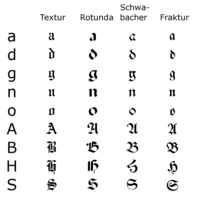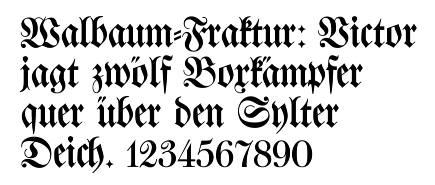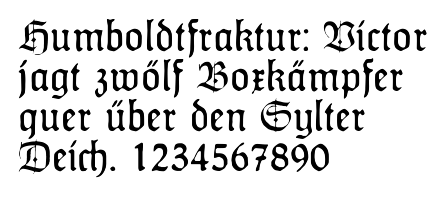Fraktur: Difference between revisions
No edit summary |
GearedBull (talk | contribs) refined categories |
||
| Line 72: | Line 72: | ||
*[http://www.i18nguy.com/surrogates.html Setting up Microsoft Windows NT, 2000 or Windows XP to support Unicode supplementary characters] |
*[http://www.i18nguy.com/surrogates.html Setting up Microsoft Windows NT, 2000 or Windows XP to support Unicode supplementary characters] |
||
[[Category:Blackletter]] |
[[Category:Blackletter]] |
||
[[Category:Typefaces]] |
|||
[[da:Fraktur (typografi)]] |
[[da:Fraktur (typografi)]] |
||
Revision as of 23:27, 22 May 2007
| Latin script (Fraktur variant) | |
|---|---|
 | |
| Script type | |
Time period | ? |
| Direction | Left-to-right |
| Languages | ? |
| ISO 15924 | |
| ISO 15924 | Latf (217), Latin (Fraktur variant) |
The German word Fraktur (IPA: [fʁaktʊɐ]) refers to a specific sub-group of blackletter typefaces. The term derives from the past participle of Latin frangere ("to break"), fractus ("broken"). As opposed to Antiqua (common) typefaces, modelled after antique Roman square capitals and Carolingian minuscule, the blackletter lines are broken up.
Sometimes, all blackletter typefaces are called fraktur.
Characteristics
One difference between the Fraktur and other blackletter scripts is that in the small-letter o, the left part of the bow is broken, but the right part is not.
Besides the 26 letters of the Latin alphabet, and the ß (ess-zet) and vowels with umlauts as well, Fraktur typefaces include the ſ (long s), sometimes a variant form of the letter r, and a variety of ligatures once intended to aid the typesetter and which have specialized rules for their use. Most older Fraktur typefaces make no distinction between the majuscules "I" and "J" (where the common shape is more suggestive of a "J"), even though the minuscules "i" and "j" are differentiated.
Origin
The first Fraktur typeface was designed when Holy Roman Emperor Maximilian I (c. 1493–1519) established a series of books and had a new typeface created specifically for this purpose. Fraktur quickly overtook the earlier Schwabacher and Textualis typefaces in popularity, and a wide variety of Fraktur fonts were carved.
Use

As opposed to other countries, in Germany, typesetting in Fraktur was entirely common still in the 19th century. Some books from the time used Schwabacher still; however, the predominant typeface was the Normalfraktur (Fig. 1), which came in various slight variations.
Since the 18th century, the Fraktur was replaced more and more by antiqua because of the obvious communication problems with non-native German speakers. The debate surrounding this move is known as the Antiqua-Fraktur dispute. However, in an attempt to deliberately differentiate Germany from the rest of the Western world, it was reinforced by Nazi Germany, which pronounced that Antiqua typefaces, particularly the neo-grotesk sans-serif favored by the Bauhaus, were not Aryan. This policy was officially upheld until January 3, 1941, when Martin Bormann issued a circular letter to all public offices which suddenly declared Fraktur to be Judenlettern (Jewish letters) and prohibited further use. It has been speculated that the régime had realized that Fraktur would inhibit communication in the territories occupied during World War II, but the main problem there was the Sütterlin-based handwriting of the German occupiers; the real reason may have been a desire to use fonts and equipment confiscated outside Germany for the printing of German language texts. Fraktur saw a short resurgence after the War because many printers did not have the money for new typefaces during the economic hardships of (roughly) 1945-1955, but after the economy started to recover it was quickly abandoned.
Fraktur is today used merely for decorative typesetting; for example, a number of traditional German newspapers still print their name in Fraktur on the first page, and it is also popular for pub signs. In this modern decorative use the Fraktur rules about long s and short s or about ligatures are often disregarded. Isolated Fraktur letters are also used in mathematics, e.g. to denote Lie algebras, σ-algebras or ring ideals.
Fraktur in Unicode
In Unicode, bold Fraktur letters (sans ß) are encoded in the Supplementary Multilingual Plane (SMP) from 1D56C-1D59F in the Mathematical Alphanumeric Symbols area. Regular Fraktur letters are encoded from 1D504-1D537 with the following exceptions: Capitals C is encoded 0212D, H 0210C, I 02111, R 0211C, Z 02128 and long s with 017F. Fraktur numerals are not encoded as of Unicode 5.0. Fraktur symbols are supported in the freeware Unicode font Code2001. These signs, however, are not meant to be used for fraktur text, but only as mathematical variables.
To show supplementary characters in Windows properly some small settings are often also necessary. Uniscribe should be loaded. This is done automatically by installing some language packs or manually by applying some register settings:
[HKEY_LOCAL_MACHINE\SOFTWARE\Microsoft\Windows NT\CurrentVersion\LanguagePack]
SURROGATE=(REG_DWORD)0x00000002
Samples
(The German sentence in the figures reads: "Victor jagt zwölf Boxkämpfer quer über den Sylter Deich". This is a nonsense sentence meaning "Victor chases twelve box fighters across the dike of Sylt", but contains all 26 letters of the alphabet plus the German umlauts and is thus an example of a pangram.)


(Hiero Rhode, 1938)
See also
- Sütterlin
- long s
- Eszett
- Emphasis (typography)
- Blackletter
- Fette Fraktur
- Antiqua-Fraktur dispute
- Fraktur (Pennsylvania German folk art)
- Pennsylvania German
- Gaelic script
References and further reading
- A complete Fraktur chart
- Website of Dieter Steffmann (in German), which has a large number of digitized Fraktur fonts
- Fraktur and German Script
- The Walden Font Co. – Purveyors of old and historic fonts and clip-art
- Blackletter: Type and National Identity
- Delbanco: German Purveyors of Fraktur fonts Template:De icon
- Bain, Peter and Paul Shaw. Blackletter: Type and National Identity. Princeton Architectural Press: 1998. ISBN 1-56898-125-2.
- Fiedl, Frederich, Nicholas Ott and Bernard Stein. Typography: An Encyclopedic Survey of Type Design and Techniques Through History. Black Dog & Leventhal: 1998. ISBN 1-57912-023-7.
- Macmillan, Neil. An A–Z of Type Designers. Yale University Press: 2006. ISBN 0-300-11151-7.
- Setting up Microsoft Windows NT, 2000 or Windows XP to support Unicode supplementary characters
